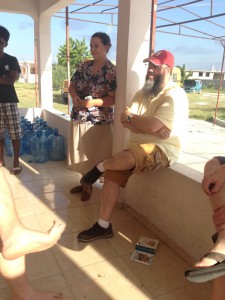 This week I’m getting the opportunity to go behind the scenes with Praying Pelican Missions during their busiest week of the summer, shadowing Haiti Operations Director Jim Noreen. (He is overseeing 7 ministry sites around the country with about 170 participants in country.)
This week I’m getting the opportunity to go behind the scenes with Praying Pelican Missions during their busiest week of the summer, shadowing Haiti Operations Director Jim Noreen. (He is overseeing 7 ministry sites around the country with about 170 participants in country.)
As of tonight I’ve seen every team and had a chance to interact with all of the individual trip leaders, who are usually a youth worker from a local church or someone in a similar paid position at a local church back home.
It’s been semi-monumental to connect with each team as Haiti isn’t exactly the easiest place to get around.
Here’s how the visits have gone. We’ll show up at a ministry location, usually during a meal. First, we’ll greet the team and then specifically spend a few minutes with the trip leader to see how they are doing. Next, Marko and I split off to find a few students to plop down in the middle of and get to know them. There’s no real agenda for that time… just getting to know one another, making small talk about their experience so far. We both love hanging out with students so that’s really fun for each of us. In the meantime, Jim is usually checking in with his staff and the host, working through any problems that may have come up, or just making sure to spend some time encouraging them. Last, in almost every stop we’ve gone back and hung out with the youth leader a bit more before letting them get back to their ministry stuff.
As I’ve met these youth leaders it’s become more and more clear how important their role is for the trip itself. Even though PPM handles all of the logistics for the trip, from transportation to food… even programming, the role of the youth leader is vital in very specific ways towards the success or failure of the trip.
4 Roles of the Youth Worker on an International Short-Term Mission Trip
- Curator – Since the youth worker has a long-term role in the students lives, she acts as a curator of the experience. Her lead-up time is crucial to recruiting and fundraising… but also that curator role continues to flesh itself out as she both experiences the trip herself and makes sure to help her students see stuff they might not normally notice. For instance, in Haiti its very easy for first-time visitors to just notice how different everything is from the States. The first day can be overwhelming because everything feels chaotic compared to home. Things seem dirty, broken down, hopeless even. But the curator can help students see the beauty in the chaos or find places of hope amidst the mess.
- Translator – A good translator doesn’t transliterate everything they are hearing. Instead they hear things in one language and translate the real meaning into the other language, which is often times not a word-for-word translation. The same is true of a youth worker when her students are on a short-term trip internationally. She can help her students understand what they are experiencing, what they are feeling, and help translate the experience into something back home. I’ve found that we are so adaptable as humans that we can sometimes falsely translate things by building up false assumptions OR we can just take the experience in so quickly that we don’t even create the space to translate it at all.
- Protector – I remember an older pastor pulling me aside early in my ministry career and reminding me that a shepherd (same word as “pastor”) carried a staff. And one purpose of the staff was to protect sheep from harm. A good youth worker will protect her students on an international mission trip. I don’t just mean safety. I also mean knowing when a student has had enough of something, or pulling the reigns in when something starts going a direction they aren’t comfortable with, or even being the one to confront another student on the trip or have a difficult conversation with a staff person from the mission agency. That doesn’t mean they have to be in control, but they do have to know when to let things go… and when to step in to protect. At the end of the day they are aware that their role isn’t just to keep people safe and trust everything will work out. Instead, it’s to make sure that the experience shapes their students spiritually in a way that represents the church, the youth ministry, and that students family.
- Reactor Core – It’s perfectly natural for participants on the trip to take non-verbal cues from their leader. If she has a lot of energy the whole team will have a lot of energy and visa versa. An experienced youth worker will recognize their role and manage it in full knowledge that everyone on the team is feeding off their attitude, work ethic, level of seriousness, level of spiritual engagement, etc. It’s easy to go on a trip and think that all of that is going to come from the mission agency. (And just kick back) But the simple reality is that you are the energy source. When your team is going well, it’s usually because of you. But when it’s going bad, it’s probably also because of your leadership as well.
What are other roles youth leaders play on international short-term mission trips? Leave a comment and add to the list with your ideas.
Leave a Reply